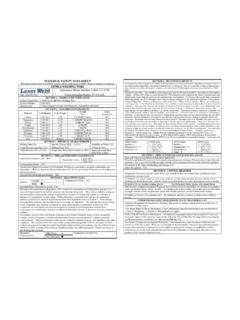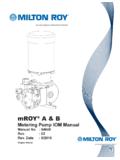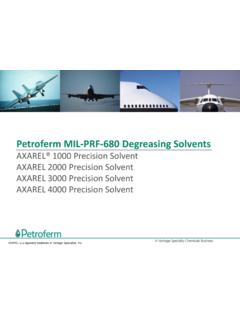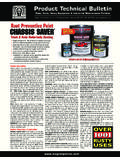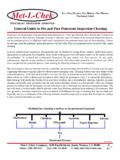Transcription of MATERIAL SAFETY DATA SHEET SECTION 5 – …
1 MATERIAL SAFETY data SHEET SECTION 5 REACTIVITY data (continued). This MATERIAL SAFETY data SHEET (MSDS) complies with the requirements of OSHA's Hazard Communication Standard. Determine the composition and quantity of fumes and gases to which workers are exposed by taking an air sample from inside the welder's helmet if worn or in the worker's breathing zone. Improve ventilation if exposures are not below limits. See 6013 WELDING ELECTRODE ANSI/AWS , , , and , available from the American Welding Society, 550 LeJeune Road, Miami, FL. Emergency Phone Number: 33126. 1-866-272-4378 SECTION 6 HEALTH HAZARD data . Carcinogenicity: The composition of welding or brazing fumes may contain carcinogens, depending on several factors that Date: May 05, 2011 Product Information Number: 575-874-9188 are unknown and unknowable to the product manufacturer (see SECTION 5).
2 Always assume that welding or brazing fumes may SECTION 1 PRODUCT IDENTIFICATION contain toxic and/or carcinogenic materials, and follow sound Work/Hygiene practices as recommended by ANSI Product Name/Class AWS E6013 Welding Electrode Threshold Limit Value: The ACGIH recommended general limit for Welding Fume NOC (Not otherwise Classified) is 5. Product Number E6013 mg/m3. ACGIH-1987-88 preface states that the TLV-TWA should be used as guides in the control of health hazards and Manufacturer Archer Company USA, Inc. 1665 Futurity Dr. Sunland Park, NM 88063 should not be used as fine lines between safe and dangerous concentrations. See SECTION 5 for specific fume constituents which may modify this TLV. Threshold Limit Values are figures published by the American Conference of Government SECTION 2 HAZARDOUS INGREDIENTS.
3 Industrial Hygienists. Units are milligrams per cubic meter of air. Effects of Overexposure: Electric arc welding may IMPORTANT! This SECTION covers the materials from which this product is manufactured. The fumes and gases create one or more of the following health hazards: Fumes and Gases can be dangerous to your health. Common entry is by produced during welding with the normal use of this product are covered by Sections 5 through 8. See these sections for inhalation. Other possible routes are skin contact and ingestion. Short-term (acute) overexposure to welding fumes may industrial hygiene information. result in discomfort such as metal fume fever, dizziness, nausea, or dryness or irritation of nose, throat, or eyes. May CAS Number shown is representative for the ingredients listed.
4 All ingredients listed may not be present in all sizes. aggravate pre-existing respiratory problems ( asthma, emphysema). Exposure to extremely high levels of fluorides can The term hazardous in Hazardous Materials should be interpreted as a term required and defined in the Hazards cause abdominal pain, diarrhea, muscular weakness, and convulsions. In extreme cases it can cause loss of consciousness Communication Standard and does not necessarily imply the existence of any hazard. and death. Long-term (chronic) overexposure to welding fumes can lead to siderosis (iron deposits in lung) and may affect TLV PEL pulmonary function. Manganese overexposure can affect the central nervous system, resulting in impaired speech and Ingredients: CAS No.
5 Weight % mg/m3 mg/m3 Supplemental Information: movement. Bronchitis and some lung fibrosis have been reported. Repeated exposure to fluorides may cause excessive Titanium dioxides 13463-67-7 10 10 10 *Not listed. Nuisance value calcification of the bone and calcification of ligaments of the ribs, pelvis and spinal column. May cause skin rash. Arc Rays (as Ti)** maximum is 10 mg/m3. PEL can injure eyes and burn skin. Skin cancer has been reported. Electric Shock can kill. If welding must be performed in Iron 7439-89-6 5 10* 10* value for iron oxide is 10 mg/m3. damp locations or with wet clothing, on metal structures or when in cramped positions such as sitting, kneeling or lying, if Mineral silicates 1332-58-7 <5 5** 5** TLV value for iron oxide is 5 there is a high risk of unavoidable or accidental contact with workpiece, use the following equipment: Semiautomatic DC.
6 Silicates and other binders 1344-09-8 <5 10* 10* mg/m3 Welder, DC Manual (Stick) Welder, or AC Welder with Reduced Voltage Control. Emergency and First Aid Procedures: Manganese and/or manganese 7439-96-5 <5 (c) ** As respirable dust. Call for medical aid. Employ first aid techniques recommended by the American Red Cross. IF BREATHING IS. alloys and compounds (as ** Subject to the reporting DIFFICULT give oxygen. IF NOT BREATHING employ CPR (Cardiopulmonary Resuscitation) techniques. IN CASE. Mn)** requirements of Sections 311, OF ELECTRICAL SHOCK, turn off power and follow recommended treatment. In all cases, call a physician. Limestone and/or calcium 1317-65-3 <5 10 15 312, and 313 of the Emergency HMIS Rating HMIS Scale NFPA Rating NFPA Scale carbonate Planning and Community Health = 2 4 = Severe Hazard Health = 1 4 = Severe Hazard Right-to-Know Act of 1986 and Flammability = 0 3 = Serious Hazard Flammability = 0 3 = Serious Hazard Cellulose and other 65996-61-4 <5 10* 10* 2 = Moderate Hazard 2 = Moderate Hazard of 40 CFR 370 and 372.
7 Reactivity = 0 Reactivity = 0. carbohydrates 1 = Slight Hazard 1 = Slight Hazard (c) Values are for manganese 0 = Minimal Hazard Other = N/A 0 = Minimal Hazard Zinc and/or zinc oxides** 1314-13-2 < 10 10. fume. STEL (Short Term Aluminum and/or aluminum 7429-90-5 < 10 15 Exposure Limit) is mg/m3 SECTION 7 PRECAUTIONS for SAFE HANDLING and USE. alloys (as Al)** Read and understand the manufacturer's instruction and the precautionary label on the product. See American National Carbon steel core wire 7439-89-6 60 10* 10* Standard , SAFETY in Welding and Cutting , published by the American Welding Society, 550 LeJeune Road, Miami, FL 33126 and OSHA Publication 2206 (29 CFR1910), Government Printing Office, Washington, 20402 for SECTION 3 PHYSICAL CHARACTERISTICS more details on many of the following: Boiling Point: N/A Specific Gravity (H2O = 1): N/A Solubility in Water: N/A Disposal Information: Discard any product, residue, disposable container, or liner as ordinary waste in an environmentally Vapor Pressure (mm Hg.)
8 Melting Point %Volatile: acceptable manner according to Federal, State and Local Regulations unless otherwise noted. N/A N/A N/A SECTION 8 CONTROL MEASURES. Vapor Density (Air = 1) Evaporation Rate (Butyl Acetate =1) Appearance and Odor: Respiratory Protection (Specify Type) Use respirable fume respirator or air supplied respirator when welding in confined N/A N/A N/A space or general work area when local exhaust or ventilation does not keep exposure below TLV. SECTION 4 FIRE and EXPLOSION HAZARD data Ventilation: Use enough ventilation, local exhaust at the arc, or both to keep the fumes and gases from the worker's Non Flammable. Welding arc and sparks can ignite combustibles and flammables. Refer to American breathing zone and the general area.
9 Train the welder to keep his head out of the fumes. Keep exposure as low as possible. National Standard for fire prevention during the use of welding and allied procedures. Eye Protection: Wear helmet or use face shield with filter lens shade number 12 or darker. Shield others by providing screens and flash goggles. SECTION 5 REACTIVITY data . Other Protective Clothing or Equipment: Wear hand, head, and body protection which help to prevent injury from radiation, Hazardous Decomposition Products: Welding fumes and gases cannot be classified simply. The composition and sparks and electrical shock. See At a minimum this includes welder's gloves and a protective face shield, and may quantity of both are dependent upon the metal being welded, the process, procedure and electrodes used.
10 Include arm protectors, aprons, hats, shoulder protection, as well as dark substantial clothing. Train the welder not to permit Other conditions which also influence the composition and quantity of the fumes and gases to which workers may be electrically live parts or electrodes to contact skin or clothing or gloves if they are wet. Insulate from work and ground. exposed include: coatings on the metal being welded (such as paint, plating, or galvanizing), the number of welders and the volume of the worker area, the quality and amount of ventilation, the position of the welder's head with respect to the OTHER INFORMATION REQUIRED BY STATE OR FEDERAL LAW. fume plume, as well as the presence of contaminants in the atmosphere (such as chlorinated hydrocarbon vapors from California Proposition 65 Information: Warning: This product contains a chemical known to the State of California to cause cleaning and degreasing activities).
